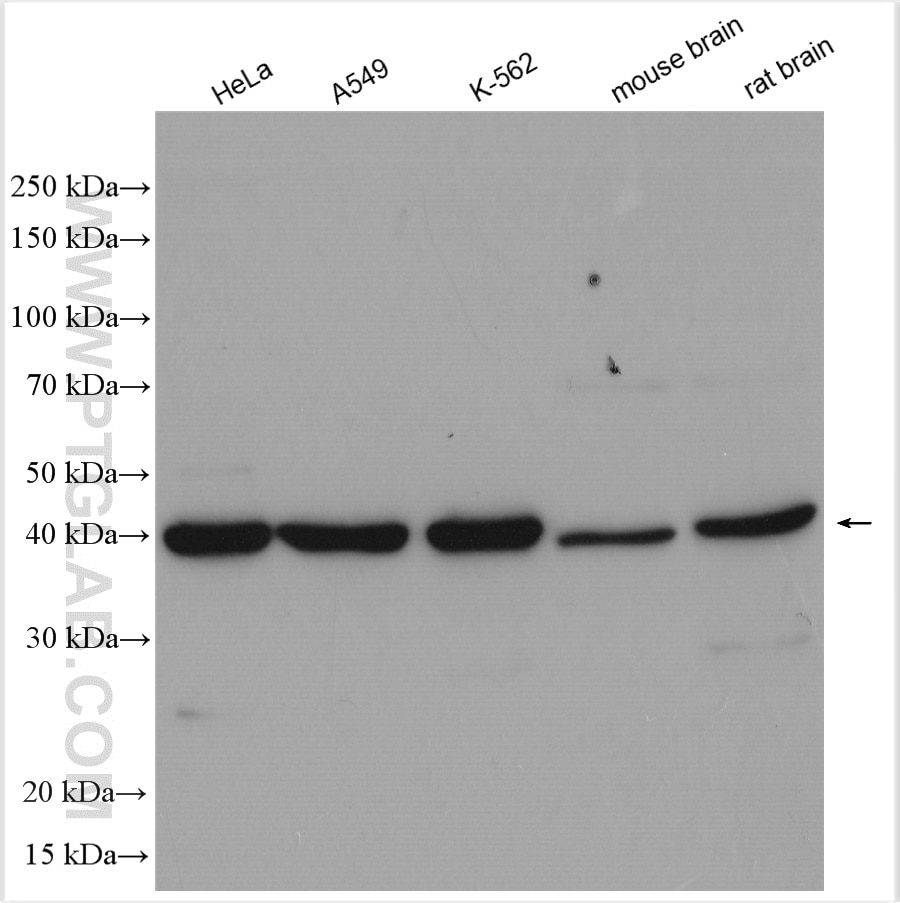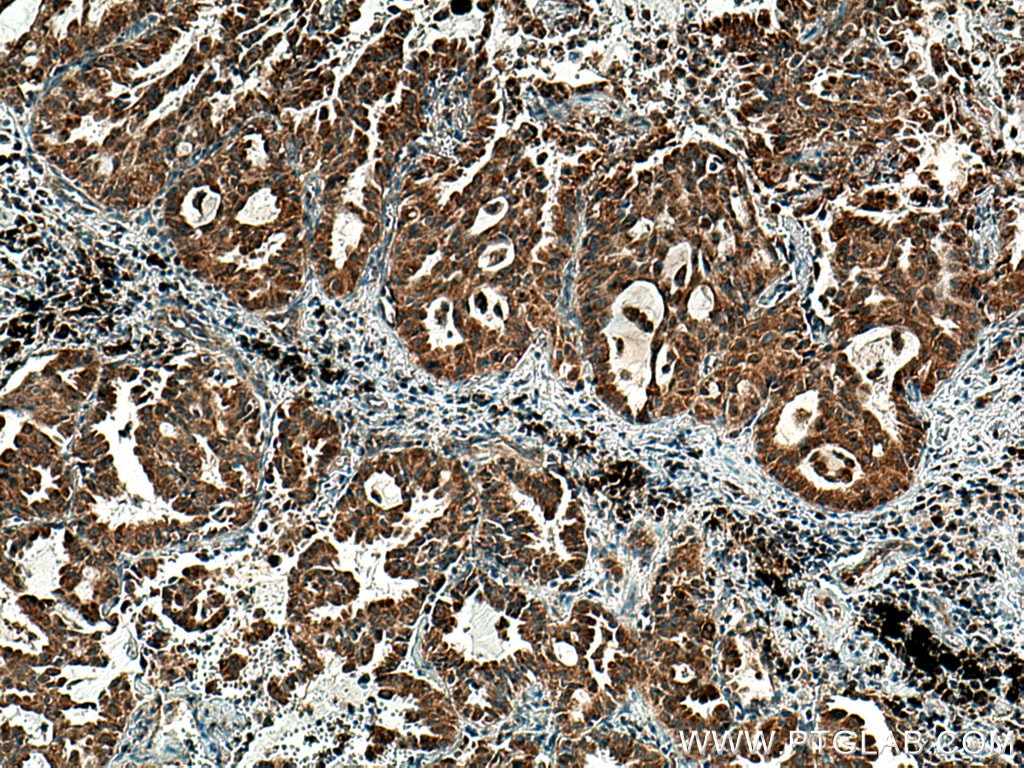Tested Applications
| Positive WB detected in | HeLa cells, HEK-293 cells, A549 cells, K-562 cells, mouse brain tissue, rat brain tissue |
| Positive IP detected in | HeLa cells |
| Positive IHC detected in | human lung cancer tissue, human breast cancer tissue Note: suggested antigen retrieval with TE buffer pH 9.0; (*) Alternatively, antigen retrieval may be performed with citrate buffer pH 6.0 |
| Positive IF/ICC detected in | HepG2 cells |
Recommended dilution
| Application | Dilution |
|---|---|
| Western Blot (WB) | WB : 1:1000-1:8000 |
| Immunoprecipitation (IP) | IP : 0.5-4.0 ug for 1.0-3.0 mg of total protein lysate |
| Immunohistochemistry (IHC) | IHC : 1:50-1:500 |
| Immunofluorescence (IF)/ICC | IF/ICC : 1:200-1:800 |
| It is recommended that this reagent should be titrated in each testing system to obtain optimal results. | |
| Sample-dependent, Check data in validation data gallery. | |
Published Applications
| WB | See 7 publications below |
| IHC | See 1 publications below |
Product Information
20180-1-AP targets PSAT1 in WB, IHC, IF/ICC, IP, ELISA applications and shows reactivity with human, mouse, rat samples.
| Tested Reactivity | human, mouse, rat |
| Cited Reactivity | human, mouse |
| Host / Isotype | Rabbit / IgG |
| Class | Polyclonal |
| Type | Antibody |
| Immunogen |
CatNo: Ag14044 Product name: Recombinant human PSAT1 protein Source: e coli.-derived, PGEX-4T Tag: GST Domain: 1-370 aa of BC001618 Sequence: MDAPRQVVNFGPGPAKLPHSVLLEIQKELLDYKGVGISVLEMSHRSSDFAKIINNTENLVRELLAVPDNYKVIFLQGGGCGQFSAVPLNLIGLKAGRCADYVVTGAWSAKAAEEAKKFGTINIVHPKLGSYTKIPDPSTWNLNPDASYVYYCANETVHGVEFDFIPDVKGAVLVCDMSSNFLSKPVDVSKFGVIFAGAQKNVGSAGVTVVIVRDDLLGFALRECPSVLEYKVQAGNSSLYNTPPCFSIYVMGLVLEWIKNNGGAAAMEKLSSIKSQTIYEIIDNSQGFYVCPVEPQNRSKMNIPFRIGNAKGDDALEKRFLDKALELNMLSLKGHRSVGGIRASLYNAVTIEDVQKLAAFMKKFLEMHQL Predict reactive species |
| Full Name | phosphoserine aminotransferase 1 |
| Calculated Molecular Weight | 370 aa, 40 kDa |
| Observed Molecular Weight | 37-40 kDa |
| GenBank Accession Number | BC001618 |
| Gene Symbol | PSAT1 |
| Gene ID (NCBI) | 29968 |
| RRID | AB_10665948 |
| Conjugate | Unconjugated |
| Form | Liquid |
| Purification Method | Antigen affinity purification |
| UNIPROT ID | Q9Y617 |
| Storage Buffer | PBS with 0.02% sodium azide and 50% glycerol, pH 7.3. |
| Storage Conditions | Store at -20°C. Stable for one year after shipment. Aliquoting is unnecessary for -20oC storage. 20ul sizes contain 0.1% BSA. |
Background Information
PSAT1, also named as PSA and PSAT, belongs to the class-V pyridoxal-phosphate-dependent aminotransferase family and SerC subfamily. It catalyzes the reversible conversion of 3-phosphohydroxypyruvate to phosphoserine and of 3-hydroxy-2-oxo-4-phosphonooxybutanoate to phosphohydroxythreonine. PSAT1 represents a new interesting target for CRC therapy. (PMID:18221502) It may be implicated in altered serine metabolism and schizophrenia spectrum conditions. (PMID:20955740 )
Protocols
| Product Specific Protocols | |
|---|---|
| IF protocol for PSAT1 antibody 20180-1-AP | Download protocol |
| IHC protocol for PSAT1 antibody 20180-1-AP | Download protocol |
| IP protocol for PSAT1 antibody 20180-1-AP | Download protocol |
| WB protocol for PSAT1 antibody 20180-1-AP | Download protocol |
| Standard Protocols | |
|---|---|
| Click here to view our Standard Protocols |
Publications
| Species | Application | Title |
|---|---|---|
Science mTORC1 induces purine synthesis through control of the mitochondrial tetrahydrofolate cycle. | ||
EMBO Mol Med Macrophages induce malignant traits in mammary epithelium via IKKε/TBK1 kinases and the serine biosynthesis pathway. | ||
Proc Natl Acad Sci U S A Interleukin-6 mediates PSAT1 expression and serine metabolism in TSC2-deficient cells. | ||
EMBO Rep The breast cancer oncogene IKKε coordinates mitochondrial function and serine metabolism. | ||
Elife The mTORC1-mediated activation of ATF4 promotes protein and glutathione synthesis downstream of growth signals. | ||
Mol Metab Hepatic mTORC1 signaling activates ATF4 as part of its metabolic response to feeding and insulin. |














